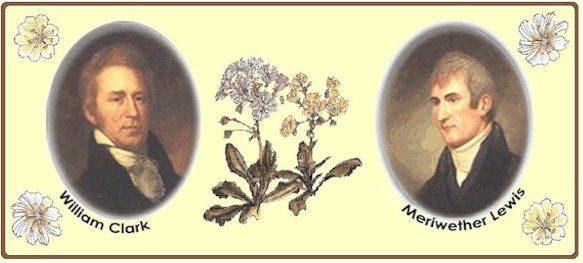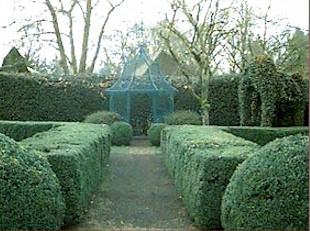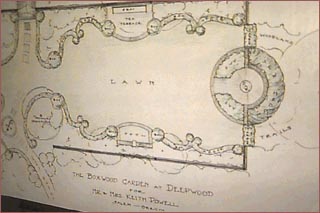WALLACE W HANSEN
Native Plants of the Northwest
Native Plant Nursery & Gardens
2158 Bower Ct S.E., Salem, Oregon 97301 E-Mail:
Wallace W Hansen
PHONE (503)581-2638 FAX(503)581-9957

WALLACE W HANSENNative Plants of the NorthwestNative Plant Nursery & Gardens2158 Bower Ct S.E., Salem, Oregon 97301 E-Mail:
Wallace W Hansen |

|
| For information about Wallace W Hansen Northwest Native Plant Nursery & Gardens: Business Information (Ordering, etc.) | |
Updated February 27, 2003 |
Wallace Hansen Celebrates Lewis and Clark |
|
|

 
|
Botanical Discoveries of the Lewis and Clark Expedition: HuckleberriesEvergreen Huckleberry (Vaccinium ovatum)Mountain Huckleberry (Vaccinium membranaceum)Fort Clatsop, Oregon, January 27, 1806 (V. ovatum) This plant was noted by Captain Lewis and it no doubt became as treasured by the members of the Expedition as it was to the Original People who introduced it. According to Pursh:
A little over a week later C. Lewis wrote about V. ovatum's brother, V. membranaceum. Fort Clatsop, Oregon, February 7, 1806 (V. membranaceum) We show the Mountain Huck with two champions of it's delicious fruit: the Golden Eagle and Yellow-bellied Marmot in a painting by Heidi Hansen. While the Mountain Huckleberry can be found from Alaska to California and east to the Great Lakes, the Evergreen Huck is native only to the Northwestern states. However, both will grow well all across North America in USDA zones 6-9 or even 10. Easy to care for, beautiful to behold and a delight to the palate, we send our thanks to Captain Lewis for recognizing the huckleberry as worthy of note. |
(Click on images for large views) |
At this time in 1806: |
Many of the expedition were ill during the winter of 1805-1806 and the
visitors from the several tribes of native peoples were not all accustomed
to the ways of these strange pioneers. Of the Chinnooks who came to the
fort on 20 February, Captain Lewis wrote:
And about the men who were ill:
More of Meriwether Lewis' thoughts on the Chinnook visit:
We can but wonder what the Chinnook people felt about these men of pale countenance. Not nearly as much has been written from that viewpoint as remains of the celebrated expedition. |
Current events: |
|
|
Deepwood Estate Museum 1894 Queen Anne Style Home Salem, Oregon Landscape architects Elizabeth Lord and Edith Schryver were commissioned by Alice Brown to create the formal gardens at Deepwood Estate. Lord and Schryver were the first formally trained women landscape architects in the Northwest. Pictured at right, top, is the 1905 Lewis & Clark Gazebo acquired by Mrs. Brown and sited at Deepwood in 1949. Below is an architectural drawing of the grounds at Deepwood. Deepwood is the most significant example of landscape architects Elizabeth Lord and Edith Schryver's Northwest work. It is their only garden design that is open to the public. Intriguing features at Deepwood include a scroll garden with a hidden signature, an ivy tunnel and a pastel tea garden. There are three other superb examples of their designs in the area, but they are associated with private residences.
|

|
|
Visitor Information 1116 Mission Street SE Salem, Oregon 97302
Deepwood grounds open dawn to dusk daily at no charge. Deepwood House Tours are 12:00-5:00 pm. hourly, May thru September, Sunday-Friday; October thru April, Tuesday-Saturday Admission: Adults, $4.00/Students and Seniors, $3.00/Children, $2.00 (under six - free)
http://www.oregonlink.com/deepwood/ House Tour Information: 503-363-1825 |

|
|
|
|
|
PICTURING THE CORPS OF DISCOVERY: The Lewis and Clark Expedition in Oregon Art An exhibit at the State Capitol building Presented by Oregon Historical Society |
|
|
December
20, 2002 through December 2004
State Capital building, 900 Court Street NE, Salem, Oregon 8 a.m. - 5 p.m. Monday - Friday 12 p.m. - 4 p.m. Saturday Closed - Sunday |
|
|
"Picturing
the Corps of Discovery demonstrates how artistic interpretations of the
Lewis and Clark Expedition mirror the history and evolving values of
Americans, and more specifically Oregonians, over the past two centuries.
Viewers will be introduced to works of art with Lewis-and-Clark themes
that reflect changing understandings of topics as diverse as democratic
ideals, ethnicity, and the environment.
A collection of images of Lewis and Clark pointing westward, including Frank Schwarz's treasured 1938 mural in Oregon's Capitol rotunda, demonstrate how the two explorers were credited with introducing civilization to the West well into the first half of the twentieth century. By the end of the century, however, works like Michael Florin Dente's 1988 sculpture, The Naming of Mount Jefferson, at the University of Portland, celebrated the expedition's ethnic mix as a historical precedent for a multicultural, pluralistic society in the West." http://www.ohs.org/exhibits/picturing-the-corp-of-discovery.cfm |
|
|
|
|
Back Issues:To see back issues of Wallace Hansen Celebrates Lewis and Clark, click on this link to jump to the index. |
|
|
The illustrated map below was created by renowned botanical artist Heidi D. Hansen especially for this website. Done in ink and watercolors, Heidi shows many of the plants Captain Lewis documented overlaid atop a map showing a portion of the journey. (Click on image for large view). |
|
|
|
|
|
|
|
|
|
|
|
|
|
|
Click here to return to my Home Page |
|
Questions about plants, click here: Regular Email to Wally To order, click here: Secure Email to Wally |
|
|
Comments or questions about our web site, click here: Webmaster |